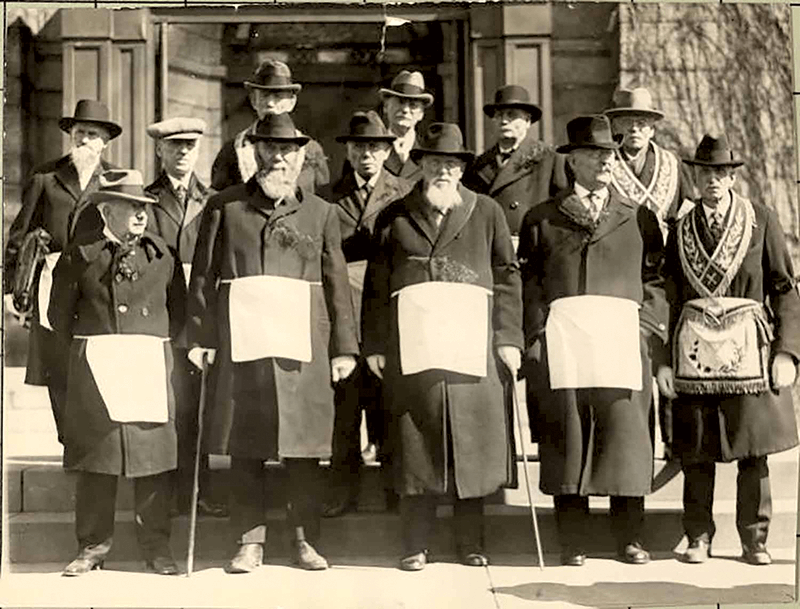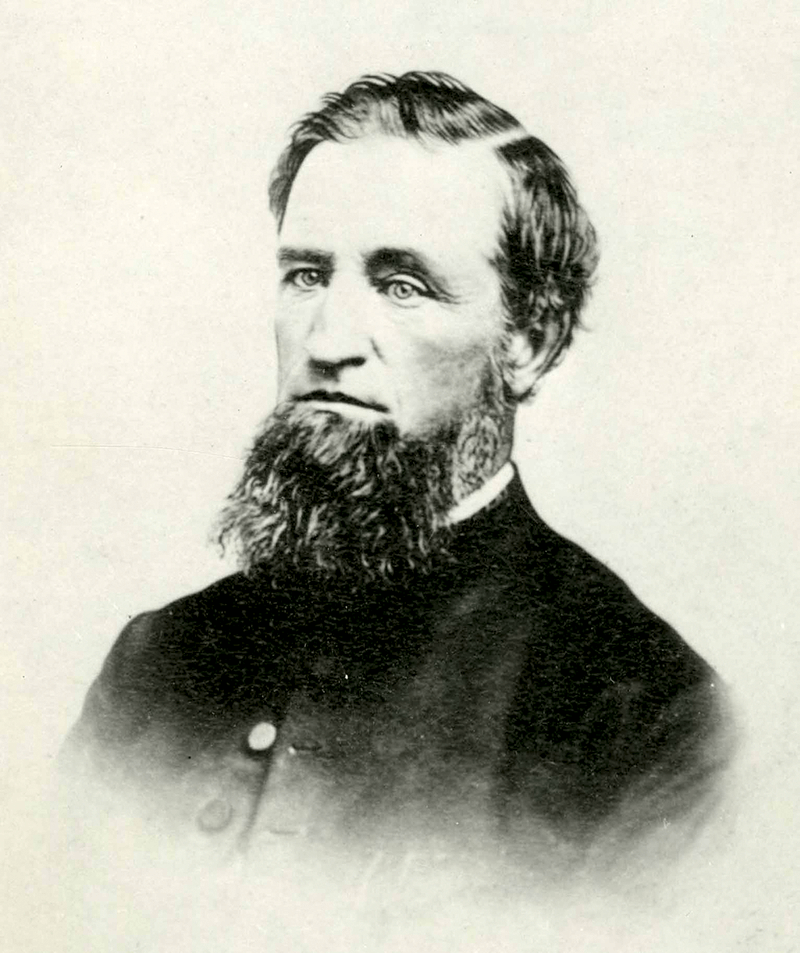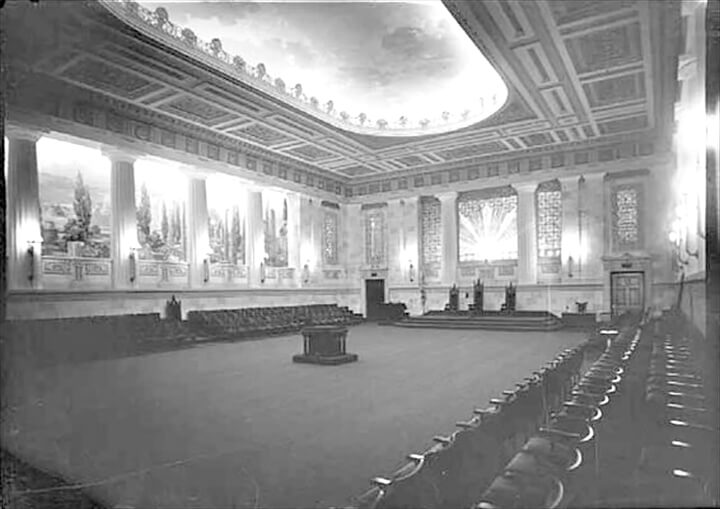
Minneapolis’ oldest Masons gathered for a photo in 1924. First row, left to right: C. B. Bemis (43 years a member), N. B. Weymouth (54 years), Merlin Camp (51 years), Richard Stanley (41 years), and E. O. Ballard (65 years). Second row: Edwin Chadwick (48 years), Frederick W. Ames (son of founder Dr. A.E. Ames, nonmember), J. J. Todd (30 years), H. S. Tuttle (40 years), Charles Copelin (23 years), G. F. Wilson (15 years), and W. G. Radke (39 years). Bemis, Weymouth and Copelin lived in Northeast. The aprons symbolize the stonemasons of medieval times. (Hennepin County Library)
In 1852, long before it was moved to Chute Square, Ard Godfrey’s little house on Main Street and 2nd Avenue SE was the site of a momentous occasion. Helen Godfrey recalled that her mother had put the house in perfect order and forbade the children from entering the parlor. “We couldn’t even peep through the keyhole,” she said. Her brother Abner was posted on the stairs outside the room to intercept intruders.
The event Helen was not allowed to see was the first formal meeting of Cataract Masonic Lodge No. 2.
The idea of a Masonic lodge in the fledgling metropolis of St. Anthony came with Dr. Alfred Elisha Ames, who arrived in Minnesota in 1851 and established a medical practice with Dr. J.H. Murphy.
Like many early settlers of Minneapolis, Ames was a New Englander, born in Vermont in 1814. He moved west to Illinois as a young man. Evidently a go-getter, he served as deputy secretary of state for Illinois and was the governor’s private secretary. He also served in the Illinois House of Representatives and the Illinois State Senate and was the postmaster of Roscoe, Ill. He was also a Master Mason. He reportedly moved to Minnesota Territory for his health.
Ames lost no time in becoming a civic leader in Minnesota. One of his first projects was to establish a Masonic Lodge. As he became familiar with his new home, he found other pioneer men who were Masons. (The Masons are a fraternal organization — no female members.) He brought them into his office, one by one, and interviewed them about their understanding of the Masons and to judge their character. He eventually found eight men who qualified and petitioned the Illinois Masons for dispensation to start a lodge in St. Anthony. (There was already a Masonic lodge in St. Paul; the new lodge pledged not to interfere with operations across the river.)
The men who formed Cataract Lodge No. 2 were to become familiar names in Minneapolis history: In addition to Ames there was William Smith, who came from Maine and was one of the first settlers to farm land east of St. Anthony; Isaac Brown, also from Maine, the first sheriff of Hennepin County; millwright Ard Godfrey; Col. John H. Stevens; J.W.T. Gardner, from Maine, a captain at Fort Snelling and graduate of West Point; Daniel M. Coolbaugh, from Pennsylvania, a builder who built many of the early stone buildings in St. Anthony; Emmanuel Case, from New York, a merchant, and who in 1853 became the first Grand Treasurer of the Grand Lodge of Minnesota.
Also among the charter members were lawyer and historian Isaac Atwater; steamboat captain Anson Northrup; Franklin Steele, the first person to stake a land claim above Ft. Snelling; and Ames’ fellow physician, J. H. Murphy.

Dr. Alfred Elisha Ames, founder of the Cataract Lodge and first Grand Master of the Grand Lodge of Minnesota (University of Minnesota)
They named it the Cataract Lodge because of its proximity to St. Anthony Falls. (Geologically speaking, a waterfall is a cataract.)
The Masons met in Godfrey’s home only once. They bounced around the city for several years before building a place of their own. The Daily Minnesota Tribune reported in 1888, “The meetings were first held in an old building on Main street northeast [sic], known as the King block, which was afterward destroyed by fire. The lodge then moved its headquarters to Rollins’ stone building on Second avenue and Prince street [renamed Lourdes Place], where they remained till the building of their present hall on University avenue.”
The Rollins building (once occupied by Crown Iron Works) served as the lodge’s headquarters from 1857 to 1874, when the Masons purchased six lots at the corner of Bank Street and University Avenue and built a hall of their own.
The laying of the cornerstone in August 1874 was a big occasion, as reported by the Minneapolis Daily Tribune: “There were about eight hundred Masons in the procession, and they presented a very creditable appearance. The police were out in their new uniforms, and for the first time in the history of the city, a procession was preceded by a good-looking, well-dressed platoon of policemen. … It was about three o’clock when the procession came up University avenue [sic] to the spot where the new building is being erected, and the procession having formed in a hollow square, the ceremonies of laying the cornerstone were gone through with.”
The building was completed and occupied by December 28. The new lodge was considered “the finest in the state.”
According to a 1926 history of the Cataract Lodge, there were 200 Masons in the lodge in 1874. The lodge’s membership continued to grow, and Ames continued to commission new lodges. Membership in the Cataract Lodge grew to 416 by the time it celebrated its fiftieth anniversary in 1902.
The Masons met at their University Avenue location until 1928, when they moved to a new building on the corner of Fourth Street and Central Avenue.
The Masonic Temple was designed to accommodate six Masonic groups. It offered space for retail tenants on the first floor and offices on the second. One of the first tenants was druggist A.C. Carlson. The upper floors were reserved for the Masons. Its cornerstone was laid Aug. 11, 1925, 51 years to the day the cornerstone was laid for the University Avenue building.
The building, which was designed by the Minneapolis architectural firm Fallows, Huey and Macomber is in the Late Gothic Revival style. Its most curious feature is an octagonal bartizan or wall-mounted turret that hangs over the corner of 4th and Central; it has no purpose whatsoever. Masonic symbols adorn the friezes on the outside of the building, and you can find representations of medieval workers throughout the building. Upper floors feature lavish plaster ornamentation painted gold. The Lodge Hall or “Gold Room” where the meetings took place featured walls lined with classical scenes and a cove-lit ceiling painted like the sky.

Unfortunately, the Masons couldn’t afford to keep their magnificent structure. Taxes were high, and when a new University Masonic lodge was chartered, 800 or more members of the Cataract Lodge defected to the new organization. In 1946, the building reverted to the State of Minnesota and the Masons moved back to their old building on University Avenue. (The University building was demolished in 1960 to make way for a parking lot.)
The temple building was purchased by the Salkin & Linoff (S&L) department stores which sold moderately priced fashions. In the mid 1960s, the building sported a large red sign that blared, “Half Price Stores.” During the 1970s it was occupied by the Campus Church and the Garden Restaurant and also housed the Minneapolis Work Opportunity Center. In 1982, Horst Rechelbacher purchased the building for his Aveda Institute, which teaches cosmetology and esthiology.
Dr. Alfred Elisha Ames did much to shape Minneapolis, in addition to the Masons. He drafted a bill for the incorporation of the city. He was responsible for a clause in the Minnesota Constitution that fixed a location for the University of Minnesota so the school could receive land grants. He gave Minneapolis two lots for a courthouse. He and Dr. David B. Knickerbocker founded a hospital for poor people, which became St. Barnabas Hospital, which became Hennepin County Medical Center.
Cataract Lodge No. 2 continues to operate today in South Minneapolis, where it shares a building with two other lodges.

The Lodge Hall or “Gold Room” at the Masonic Temple in 1926. It is now the home of Aveda Institute. (Minnesota Historical Society)
Sources:
MacGregor, Ardis, “Restoration of the Ard Godfrey House,” Hennepin History, Winter 1979-1980, Vol. 38, No. 4
“The Masons Grand Procession by Nearly Thousand of Their Order,” Minneapolis Daily Tribune, Aug. 12, 1874
“Secret Societies. They have kept pace with the growth of the city,” Daily Minnesota Tribune, Dec. 31, 1888
“Masons celebrate jubilee of lodge,” Minneapolis Daily Times, Oct. 5, 1902
Olson, Gail, “Old OSA’s Central Avenue landmarks,” Northeaster, Feb. 24, 1997
Cataract Lodge No. 2, 1852-1926, annual report
Cataract Lodge No. 2 sesquicentennial booklet, Minneapolis, 2002
https://cataracthistory.blogspot.com/2015/07/alfred-elisha-ames-1st-master-of.html